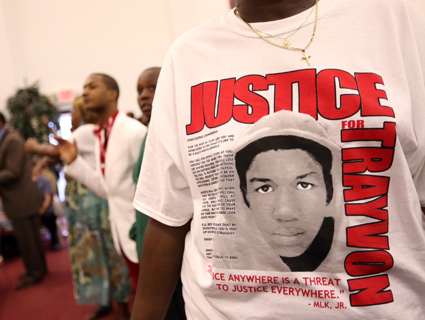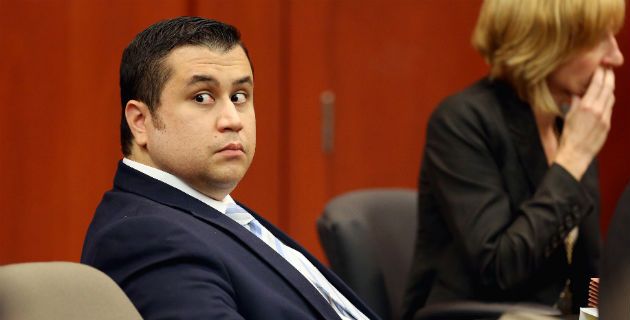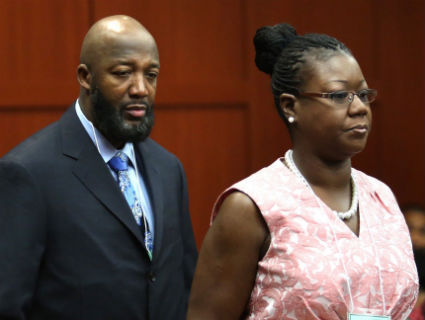On Black Friday 2012, 17-year-old Jordan Davis, who was sitting with three friends in a car at a Florida gas station, cranked up the rap on the stereo. Three and a half minutes later, he was dead, shot at 10 times by Michael Dunn, a middle-aged white man bristling at the black teens’ “thug music.” In a new documentary, 3-1/2 Minutes, Ten Bullets, director Marc Silver explores the perfect storm of racism and lax gun laws that led to the killing.
The film, which opened in theaters this month, comes at a time when a lot of racially motivated tragedies have been in the news—the most recent being the church massacre in Charleston, South Carolina. Jordan’s death wasn’t classified as a hate crime, but the film makes an implicit argument for Dunn’s racial motivations, zooming in on his testimony and his jailhouse phone calls with his girlfriend, in which he insists the teens were armed and dangerous—no gun was found—and that he acted in self defense. Throughout, the film touches on the murky legal ground at the nexus of bias and self-defense laws: What constitutes a “reasonable belief” that one’s life is in danger when that belief may be borne out of racial stereotypes?
The film documents both of Dunn’s trials—the first, which ended in a hung jury, and the second, in which he was convicted of first degree murder and sentenced to life without parole. Silver follows Ron Davis and Lucia McBath, Jordan’s parents, as they go to court each day and wait for the final verdict in their son’s death. The pair must maintain their decorum in the courtroom as the defense vilifies their son and his friends—all while wondering whether his legacy will match that of another unarmed Florida teen whose shooter walked free; in one scene, Jordan’s father recalls a text he got from Trayvon Martin’s dad: “I just want to welcome you to a club that none of us want to be in.”
Mother Jones: Tell me a little about why you decided to make this film.
Marc Silver: I saw a tension, a film that would be able to explore this awful moment when two cars happen to pull up next to each other, and within that coincidence this tragedy that consisted of racial profiling, access to guns, and laws that give people the confidence to use those guns. It was unique that you would be able to deconstruct this one tight moment and come out with the big, macro issues. I also felt like it was important to learn about Michael Dunn. I was interested in the idea that there would be audience members who would have some sense of empathy with him at the outset, who also might have felt fear when a car full of young black teenagers pulled up and they start having an argument over music. Through Michael Dunn, you learn about many other people in America who have that same implicit bias, and it might make audiences look at themselves in a different way.
MJ: Jordan’s parents, Ron and Lucy, are featured prominently. You capture some heart-wrenching moments. How did you get that kind of access?
MS: I shoot and do sound on my own, so I’m not approaching them with a big crew and lights and all the rest of it. That’s the technical answer. There was also a huge emotional relationship. We met about seven months before the trial. By the time the trial came, I asked, “Would you be okay if I did several mornings with you and several evenings? It’s really important that the audience gets to see not just you guys sitting there stoically in court, but actually what impact this really has on you.” They were very open to that. They could see the bigger picture, in terms of audiences really understanding that, however many shootings and racist incidents there are in the US, that this is the effect.
MJ: It does feel like, since Ferguson, we hear news about the killing of black men almost daily.
MS: I really hope people walk away from the film remembering that there are concentric circles around these events. If you put these on a map and you actually counted the number of people affected, that would be a very different picture. It’s not just families; it’s communities.
MJ: What was it like documenting Ron and Lucy’s trepidation?
MS: That was a horrific journey. We could feel the tension, the exhaustion, the horror of having to sit through the trial. Every day in the courtroom, the judge reminded people that they weren’t allowed to show emotion—I presume [because] it might affect the jury. They also weren’t allowed to talk about race because it wasn’t officially declared a hate crime. That’s when I understood this difference between the cold environment of the courtroom and this emotional, every-parent’s-worst-nightmare story unfolding outside the courtroom that the public were finding themselves attached to—because clearly it was about racism.
MJ: A second thread in the film touches on stand your ground and gun laws. What made you decide to toggle between those two plotlines?
MS: The 50 pages, or whatever it was, of self-defense laws the judge had to read out to the jury lasted about 30 minutes. That obviously wasn’t going to work in the film. And the specifics are really difficult to explain. So we put that across to the audience in the simplest way possible by using the jury—in the way the prosecutor, the defense, and the judge explained self defense. It was essential that we embedded that into the story. Of course, you come up against something really weird: Trayvon Martin wasn’t a stand-your-ground case. Jordan Davis’ case wasn’t a stand-your-ground case. That really complicates stuff.
We really didn’t get into gun control because the heart of the film is about race. There are subsequent things in the film that may make you think about gun control without us having to slap you with it. One was the white witness [at the gas station]: He describes the gun in such great detail. To be able to say the name, make, and model of a gun you saw for a split second goes to show how embedded gun culture is in Florida.
MJ: You’re from the UK, which treats firearms very differently than the United States does. How did that affect the film’s outlook?
MS: I like to think that it gave me a less judgmental perspective. It’s always weird coming to the US and seeing how powerful the gun lobby is and how passionate some people are about the use of guns when you come from a place where hardly any of our police have guns. I understand philosophically the right to self-defense and the Second Amendment. But consider what practical effect these concepts have. It’s very simple: If there wasn’t a gun in Michael Dunn’s car, Jordan Davis would not be dead, and Michael Dunn would not be spending the rest of his life in prison. The gun created a totally different narrative.
MJ: You’re also white. Did that affect the process in any way?
MS: I didn’t feel it hindered my making the film. That’s not to say if I was African American, or American, or owned a gun, I may not have told the story in a different way. But being white made me want to explore what proportion of white America Michael Dunn represents.
MJ: Did you find an answer?
MS: I always had a suspicion that Dunn’s perception of race was wildly skewed. Then we found the prison phone calls. The way he described, as you hear in the film, his conviction that Jordan’s friends are thugs, that they won’t tell the truth in court, that him killing Jordan actually potentially saved someone else’s life because Jordan didn’t get to kill somebody else. And that all of this is related to baggy pants, their fathers not being around, and MTV. The belief system he had in place led to Jordan’s killing. And there were some things that Michael Dunn said that were, for me, metaphorical of what many white people in America say and how they perceive black men. A lot of people think that MTV is this, or all black fathers are that. I don’t know how many people who have those opinions would then reach for their gun. But I think a lot of people have those opinions. Michael Dunn is just one person, but what he comes to represent is much more interesting.
Also, I thought one of the maddest things about Dunn’s rant about black fathers not being present was this amazing irony that Dunn had not seen his son in many years and was literally going to his estranged son’s wedding that day. So he would be a not-present father, and Ron, Jordan’s dad, would be ever-present father. Even in death, Ron is essentially fathering and standing up for his son.
MJ: You started this film before Ferguson got more of America talking about race again. How has the explosion of debate on this topic affected the final product?
MS: I remember we were sitting in the edit suite watching Ferguson erupt on Facebook and in the media. There were moments when we were itching to go out and shoot, not really knowing why. So we held ourselves back. But actually that was the wisest thing. Because Jordan’s story held within its DNA all of these layers that not only spoke to what happened specifically to him, but spoke to bigger things that were, and obviously have been happening in the US for many years—this year in particular. All of that had already happened before Ferguson. So technically nothing changed on the timeline. It just resonated more powerfully.
Ferguson happened in between the two [Dunn] trials. Members of the public obviously knew it had happened, and then 12 of those members of the public ended up on the second jury. I’ve always wondered if some social change had actually occurred. Whether that second jury had been affected by what happened in Ferguson, and they did look at racial bias in a different way and thought, “This isn’t self defense.” I could never prove that, but I like to think that sometimes.
















